Synthesis and Photoluminescent Properties of Dy3+-Doped and Dy3+/Eu3+ Co-Doped 50ZnO:40B2O3:5WO3:Nb2O5 Glass
Abstract
1. Introduction
2. Results
2.1. XRD Data and Thermal Analysis
2.2. Physical Properties
2.3. Raman Analysis
2.4. Photoluminescent Properties
3. Materials and Methods
4. Conclusions
Author Contributions
Funding
Institutional Review Board Statement
Informed Consent Statement
Data Availability Statement
Acknowledgments
Conflicts of Interest
References
- Zhang, S.; Qin, S.; Xiao, Y.; Liu, Z.; Hu, X.; Xiao, Z.; Huang, D.; Han, L.; Ye, X. Near-infrared luminescent materials: A review of their practical applications and prospective advancements. Dalton Trans. 2025, 54, 6717–6740. [Google Scholar] [CrossRef] [PubMed]
- Schröder, F.; Reetz, S.; Jüstel, T. On the Energy Dependence of the PL of RE Ions in LuBO3:RE (RE = Ce, Eu, Gd, or Tb). Crystals 2024, 14, 341. [Google Scholar] [CrossRef]
- Dahiya, J.; Hooda, A.; Agarwal, A.; Khasa, S. Tuneable colour flexibility in Dy3+&Eu3+co-doped lithium fluoride bismuth borate glass system for solid state lighting applications. J. Non-Cryst. Solids 2022, 576, 121237. [Google Scholar]
- Krishna Reddy, D.V.; Sambasiva Rao, T.; Taherunnisa, S.; Suchocki, A.; Zhydachevskyy, Y.; Piaseckic, M.; Rami Reddy, M. Tunable white light by varying excitations in yttrium alumino bismuth borosilicate glasses co-doped with Dy3+-Eu3+ for cool WLED applications. J. Non-Cryst. Solids 2019, 513, 167–182. [Google Scholar] [CrossRef]
- An, J.; Zhang, S.; Liu, R.; Hu, G.; Zhang, Z.; Qiu, Y.; Zhou, Y.F.; Su, Z.Z. Luminescent properties of Dy3+/Eu3+ doped fluorescent glass for white LED based on oxyfluoride matrix. J. Rare Earths 2021, 39, 26–32. [Google Scholar] [CrossRef]
- Yanga, J.; Sohn, I. Compositional dependence of thermophysical properties in binary alkaline earth borate melts: Insights from structure in short-range and intermediate-range order. J. Mater. Sci. Technol. 2022, 131, 195–203. [Google Scholar] [CrossRef]
- Boussetta, A.; Al-Syadi, A.M.; Damak, K.; Ersundu, A.E.; Ersundu, M.C.; Ramadan, E.; Alshehri, A.M.; Hussein, K.I.; Maalej, R.; Yousef, E.S. Investigation of Thermal and Spectroscopic Properties of Tellurite-Based Glasses Doped with Rare-Earth Oxides for Infrared Solid-State Lasers. Materials 2024, 17, 3717. [Google Scholar] [CrossRef]
- Milewska, K.; Maciejewski, M.; Žitňan, M.; Velázquez, J.J.; Galusek, D.; Sadowski, W.; Kościelska, B. Tunable emission and energy transfer of B2O3–Bi2O3–AlF3 glass system doped with Eu3+/Dy3+. J. Lumin. 2024, 269, 120440. [Google Scholar] [CrossRef]
- Hussain, S.K.; Yu, J.S. Bluish-green emission of novel BaAl2Ge2O8:Eu2+ phosphors under near-ultraviolet excitation. J. Rare Earths 2025, 43, 30–38. [Google Scholar] [CrossRef]
- Li, Y.; Xu, S.; Chen, J.; Wang, X.; Gong, S.; Zhang, X.; Huisheng, L.; Chi, Y.; Sun, X.; Mahadevan, C.K. Towards white light emission in Dy3+/Sm3+ co-doped niobio silicate glasses via adjusting doping concentration and excitation wavelength for w-LED applications. Ceram. Int. 2024, 50, 25548–25557. [Google Scholar] [CrossRef]
- Zissis, G. Energy consumption and environmental and economic impact of lighting: The current situation. In Handbook of Advanced Lighting Technology; Karlicek, R., Sun, C.C., Zissis, G., Ma, R., Eds.; Springer: Cham, Switzerland, 2016. [Google Scholar]
- Erol, E.; Vahedigharehchopogh, N.; Kıbrıslı, O.; Ersundu, M.C.; Ersundu, A.E. Recent progress in lanthanide-doped luminescent glasses for solid-state lighting applications—A review. J. Phys. Condens. Matter. 2021, 33, 483001. [Google Scholar] [CrossRef] [PubMed]
- Lewandowskia, T.; Seweryński, C.; Walasa, M.; Łapiński, M.; Synak, A.; Sadowski, W.; Kościelska, B. Structural and luminescent study of TeO2-BaO-Bi2O3-Ag glass systemdoped with Eu3+ and Dy3+ for possible color-tunable phosphor. Opt. Mater. 2018, 79, 390–396. [Google Scholar] [CrossRef]
- Zhang, F.; Cao, Q.; Lu, J.; Tao, H.; Yang, S.; Yao, S.; Fu, Q.; Ma, Z.; Dai, W.; Zhao, H. Adjusting photoluminescence of high thermostability Dy3+/Eu3+ co-doped borosilicate glass for white LED device. Ceram. Int. 2024, 50, 35557–35567. [Google Scholar] [CrossRef]
- Diaz-Torres, L.A.; De la Rosa, E.; Salas, P.; Romero, V.H.; Angeles-Chavez, C. Efficient photoluminescence of Dy3+ at low concentrations in nanocrystalline ZrO2. J. Solid State Chem. 2008, 181, 75–80. [Google Scholar] [CrossRef]
- Blasse, G.B.; Grabmaier, C. Luminescent Materials; Springer: Berlin/Heidelberg, Germany, 1994. [Google Scholar]
- Fhoula, M.; Koubaa, T.; Dammak, M. White photoluminescence and energy transfer properties of Dysprosium and Europium singly and codoped Na2ZnP2O7 phosphors. Optics Laser Technol. 2020, 130, 106352. [Google Scholar] [CrossRef]
- Griebenow, K.; Phuong-Truong, M.; Munoz, F.; Klement, R.; Galusek, D. Tuning the fluorecence of Dy3+ via the structure of borophosphate glasses. Sci. Rep. 2023, 13, 1919. [Google Scholar] [CrossRef]
- Griebenow, K.; Munoz, F.; Tagiara, N.S.; Klement, R.; Prnova, A.; Wolfrum, B.; Kamitsos, E.I.; Duran, A.; Galusek, D. Structure and fluorescence properties of Dy doped alkaline earth borophosphate glasses. Int. J. Appl. Glass Sci. 2021, 12, 472–484. [Google Scholar] [CrossRef]
- Zhu, Z.; Tao, C.; Wang, Z.; Yang, Z.; Li, P. Luminescence and energy transfer of warm white-emitting phosphor Mg2Y2Al2Si2O12:Dy3+,Eu3+ for white LEDs. RSC Adv. 2021, 11, 32707–32716. [Google Scholar] [CrossRef]
- Teixeira, M.M.; Pinatti, I.M.; Laranjeira, J.A.S.; Fabris, G.S.L.; Teodoro, M.D.; Rosa, I.L.V.; Simoes, A.Z.; Andrés, J.; Sambrano, J.R.; Longo, E. Photoluminescence of Ca10V6O25:Eu3+: A theoretical and experimental approach. J. Alloys Compd. 2024, 980, 173525. [Google Scholar] [CrossRef]
- Parauha, Y.R.; Halwar, D.K.; Dhoble, S.J. Photoluminescence properties of Eu3+-doped Na2CaSiO4 phosphor prepared by wet-chemical synthesis route. Displays 2022, 75, 102304. [Google Scholar] [CrossRef]
- Rodríguez-Carvajal, D.A.; Meza-Rocha, A.N.; Caldino, U.; Lozada-Morales, R.; Alvarez, E.; Zayas, M.E. Reddish-orange, neutral and warm white emissions in Eu3+, Dy3+ and Dy3+/Eu3+ doped CdO-GeO2-TeO2 glasses. Solid State Sci. 2016, 61, 70–76. [Google Scholar] [CrossRef]
- Yu, P.; Guo, W.; Zhang, R.; Su, L.; Xu, J. White and tunable light emission in Eu3+, Dy3+ codoped phosphate glass. Opt. Mater. 2021, 114, 110939. [Google Scholar] [CrossRef]
- Mukamil, S.; Sarumaha, C.; Wabaidur, S.M.; Islam, M.A.; Khattak, S.A.; Kothan, S.; Shoaib, M.; Khan, I.; Ullah, I.; Kaewkhao, J.; et al. Investigation of color tenability of Dy3+ & Eu3+ Co-doped bismuth borate glasses for lighting applications. Mater. Chem. Phys. 2022, 288, 126422. [Google Scholar]
- Meza-Rocha, A.N.; Speghini, A.; Bettinelli, M.; Caldiñ, U. White light generation through Zn(PO3)2 glass activated with Eu3+ and Dy3+. J. Lumin. 2016, 176, 235–239. [Google Scholar] [CrossRef]
- Li, W.; Chen, Z.; Zhang, B.; Zhao, P.; Fan, Y. Luminescence properties and thermal stability of Dy3+/Eu3+ co-doped single-component BaZn2(PO4)2 glass-ceramic phosphors. J. Lumin. 2022, 246, 118824. [Google Scholar] [CrossRef]
- Aleksandrov, L.; Milanova, M.; Yordanova, A.; Iordanova, R.; Nedyalkov, N.; Petrova, P.; Tagiara, N.S.; Palles, D.; Kamitsos, E.I. Synthesis, structure and luminescence properties of Eu3+-doped 50ZnO.40B2O3.5WO3.5Nb2O5 glass. Phys. Chem. Glasses Eur. J. Glass Sci. Technol. B 2023, 64, 101–109. [Google Scholar]
- Aryal, P.; Kesavulu, C.R.; Kim, H.J.; Lee, S.W.; Kang, S.J.; Kaewkhao, J.; Chanthima, N.; Damdee, B. Optical and luminescence characteristics of Eu3 +- doped B2O3:SiO2:Y2O3:CaO glasses for visible red laser and scintillation material applications. J. Rare Earth 2018, 36, 482–491. [Google Scholar] [CrossRef]
- Villegas, M.A.; Fernández Navarro, J.M. Physical and structural properties of glasses in the TeO2–TiO2–Nb2O5 system. J. Eur. Ceram. Soc. 2007, 27, 2715–2723. [Google Scholar] [CrossRef]
- El Jouad, M.; Touhtouh, S.; Addou, M.; Ollier, N.; Sahraoui, B. Red luminescence and ultraviolet light generation of europium doped zincoxide thin films for optoelectronic applications. EPJ Appl. Phys. 2020, 91, 10501. [Google Scholar] [CrossRef]
- Iordanova, R.; Milanova, M.; Aleksandrov, L.; Shinozaki, K. Structural study of WO3-La2O3-B2O3-Nb2O5 glasses. J. Non-Cryst. Solids 2020, 543, 120132. [Google Scholar] [CrossRef]
- Yao, Z.; Möncke, D.; Kamitsos, E.I.; Houizot, P.; Célarié, F.; Rouxel, T.; Wondraczek, L. Structure and mechanical properties of cooper-lead and copper-zinc borate glasses. J. Non-Cryst. Solids 2016, 435, 55–68. [Google Scholar] [CrossRef]
- Chen, Q.; Zhang, M.; Ma, Q.; Wang, Q. The structure, spectra and properties of Dy2O3 modified diamagentic lead bismuth-germanium glasses. J. Non-Cryst. Solids 2019, 507, 46–55. [Google Scholar] [CrossRef]
- Milanova, M.; Aleksandrov, L.; Yordanova, A.; Iordanova, R.; Tagiara, N.S.; Herrmann, A.; Gao, G.; Wondraczek, L.; Kamitsos, E.I. Structural and luminescence behavior of Eu3+ ions in ZnO-B2O3-WO3 glasses. J. Non-Cryst. Solids 2023, 600, 122006. [Google Scholar] [CrossRef]
- Daturi, M.; Busca, G.; Borel, M.M.; Leclaire, A.; Piaggio, P. Vibrational and XRD Study of the System CdWO4-CdMoO4. J. Phys. Chem. B 1997, 101, 4358–4369. [Google Scholar] [CrossRef]
- Winterstein-Beckmann, A.; Möncke, D.; Palles, D.; Kamitsos, E.I.; Wondraczek, L. Structure and Properties of Orthoborate Glasses in the Eu2O3–(Sr,Eu)O–B2O3 Quaternary. J. Phys. Chem. B 2015, 119, 3259–3272. [Google Scholar] [CrossRef]
- He, F.; He, Z.; Xie, J.; Li, Y. IR and Raman Spectra Properties of Bi2O3-ZnO-B2O3-BaO Quaternary Glass System. Am. J. Anal. Chem. 2014, 5, 1142–1150. [Google Scholar] [CrossRef]
- Carnall, W.T.; Fields, P.R.; Rajnak, K. Electronic energy levels in the trivalent lanthanide aquo ions. I. Pr3+, Nd3+, Pm3+, Sm3+, Dy3+, Ho3+, Er3+, and Tm3+. J. Chem. Phys. 1968, 49, 4424–4442. [Google Scholar] [CrossRef]
- Chemingui, S.; Ferhi, M.; Horchani-Naifer, K.; Férid, M. Synthesis and luminescence characteristics of Dy3+ doped KLa(PO3)4. J. Lumin. 2015, 166, 82–87. [Google Scholar] [CrossRef]
- Dutta, P.S.; Khanna, A. Eu3+ activated molybdate and tungstate based red phosphors with charge transfer band in blue region. ECS J. Solid State Sci. Technol. 2013, 2, R3153–R3167. [Google Scholar] [CrossRef]
- Zeng, H.; Song, J.; Chen, D.; Yuan, S.; Jiang, X.; Cheng, Y.; Chen, G. Three-photon-excited upconversion luminescence of niobium ions doped silicate glass by a femtosecond laser irradiation. Opt. Express 2008, 16, 6502–6506. [Google Scholar] [CrossRef]
- Thieme, C.; Herrmann, A.; Kracker, M.; Patzig, C.; Höche, T.; Rüssel, C. Microstructure investigation and fluorescence properties of europium-doped scheelite crystals in glass-ceramics made under different synthesis conditions. J. Lumin. 2021, 238, 118244. [Google Scholar] [CrossRef]
- Ju, G.F.; Hu, Y.H.; Chen, L.; Wang, X.J.; Mu, Z.F. Concentration quenching of persistent luminescence. Physica B 2013, 415, 1–4. [Google Scholar] [CrossRef]
- Su, Q.; Pei, Z.; Chi, L.; Zhang, H.; Zhang, Z.; Zou, F. The yellow-to-blue intensity ratio (Y/B) of Dy3+ emission. J. Alloys Compd. 1993, 192, 25–27. [Google Scholar] [CrossRef]
- Wang, X.; Li, X.; Xu, S.; Cheng, L.; Sun, J.; Zhang, J.; Zhang, X.; Chen, B. Luminescence properties of color-tunable YNbO4: Dy3+, Tm3+ phosphors. J. Asian Ceram. Soc. 2020, 8, 1066–1075. [Google Scholar] [CrossRef]
- Vijayalakshmi, L.; Kumar, K.N.; Baek, J.D. Multicolor and warm white luminescence from Dy3+/Eu3+ co-activated glasses for indoor and solid-state lighting applications. Ceram. Int. 2023, 49, 5013–5021. [Google Scholar] [CrossRef]
- Liu, R.; Wang, D.; Chen, M.; Liu, L.; Zhou, Y.; Zeng, F.; Su, Z. Luminescence, energy transfer properties of Dy3+/Eu3+ coactivated neutral and warm white emissions GSBG glasses. J. Lumin. 2021, 237, 118180. [Google Scholar] [CrossRef]
- Smith, T.; Guild, J. The CIE colorimetric standards and their use. Trans. Opt. Soc. 1931, 33, 73. [Google Scholar] [CrossRef]
- Paolini, T.B. SpectraChroma (Version 1.0.1) [Computer Software]. 2021. Available online: https://zenodo.org/records/4906590 (accessed on 7 June 2021).
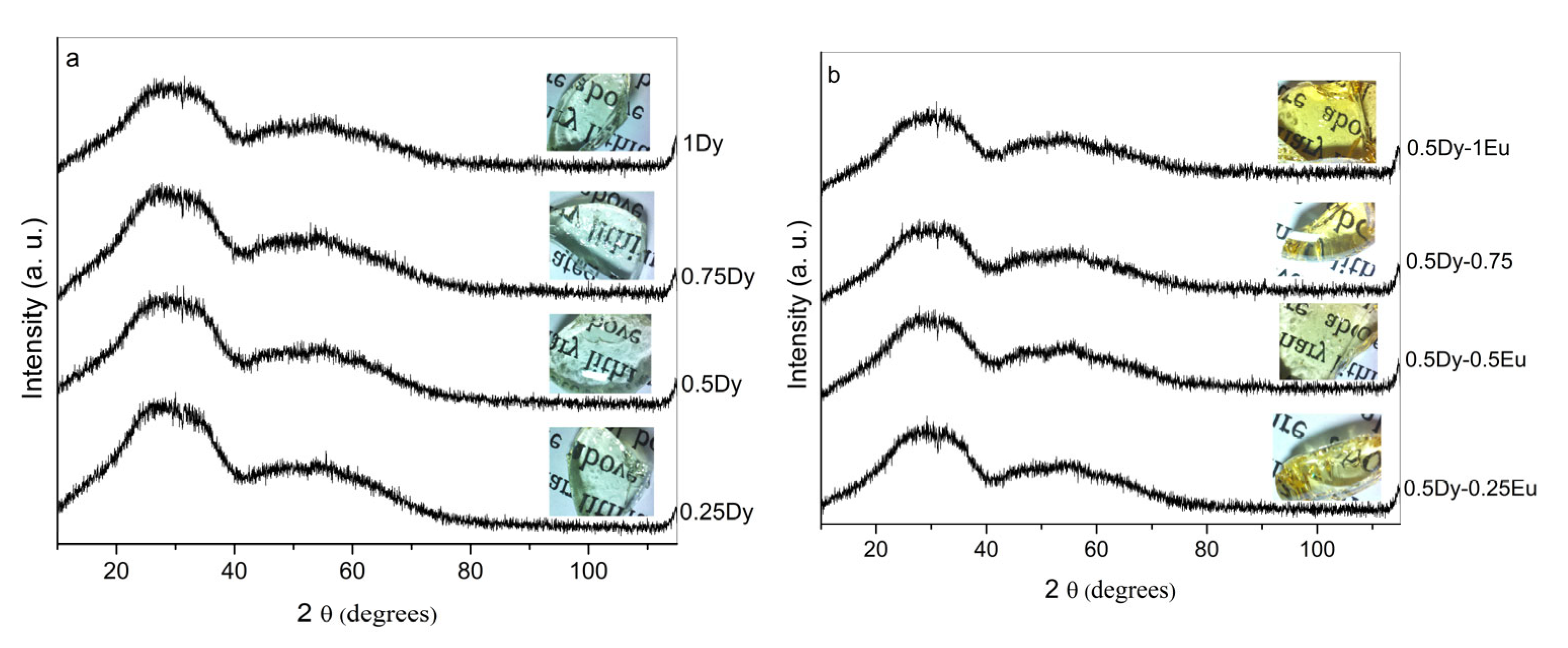

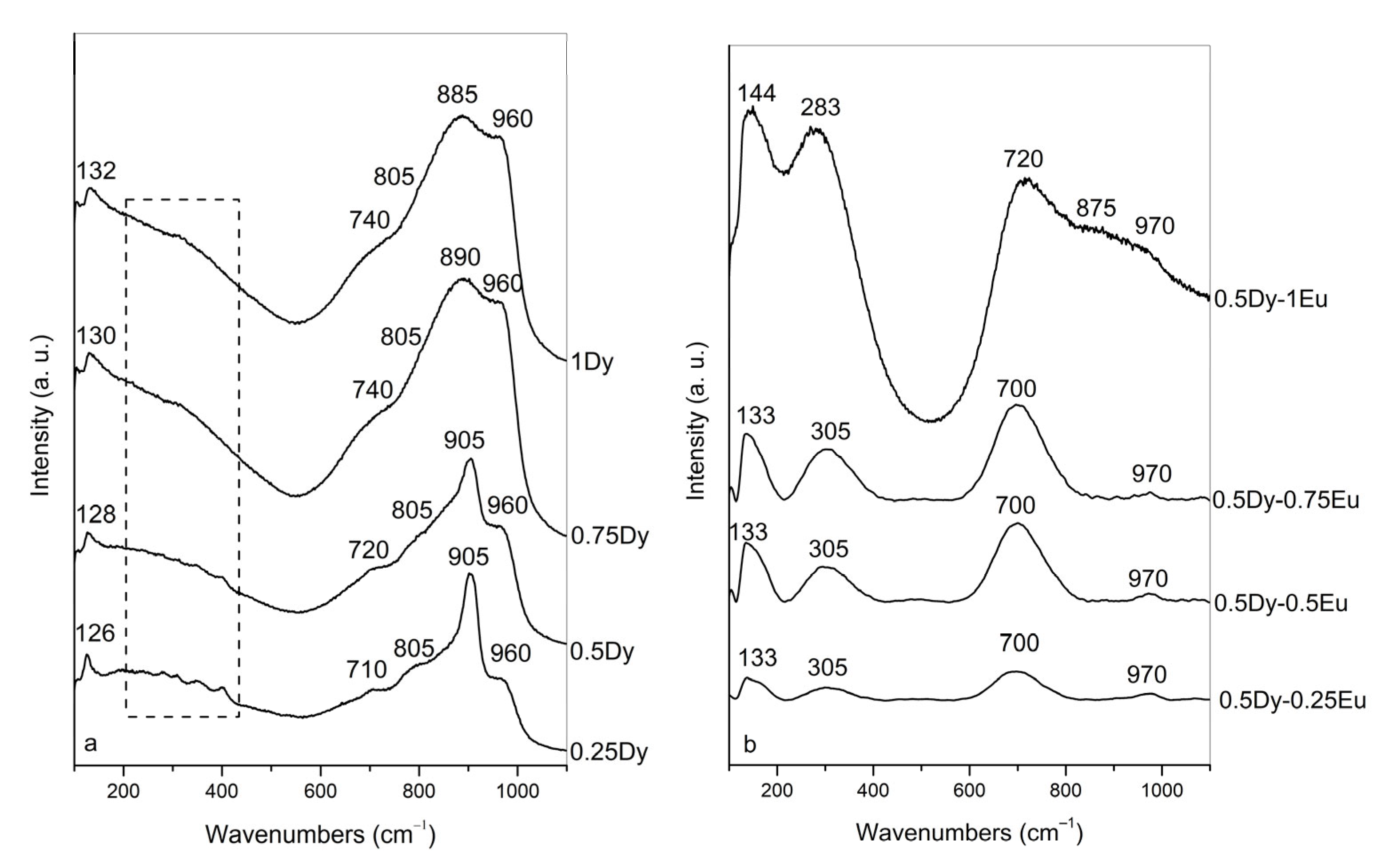

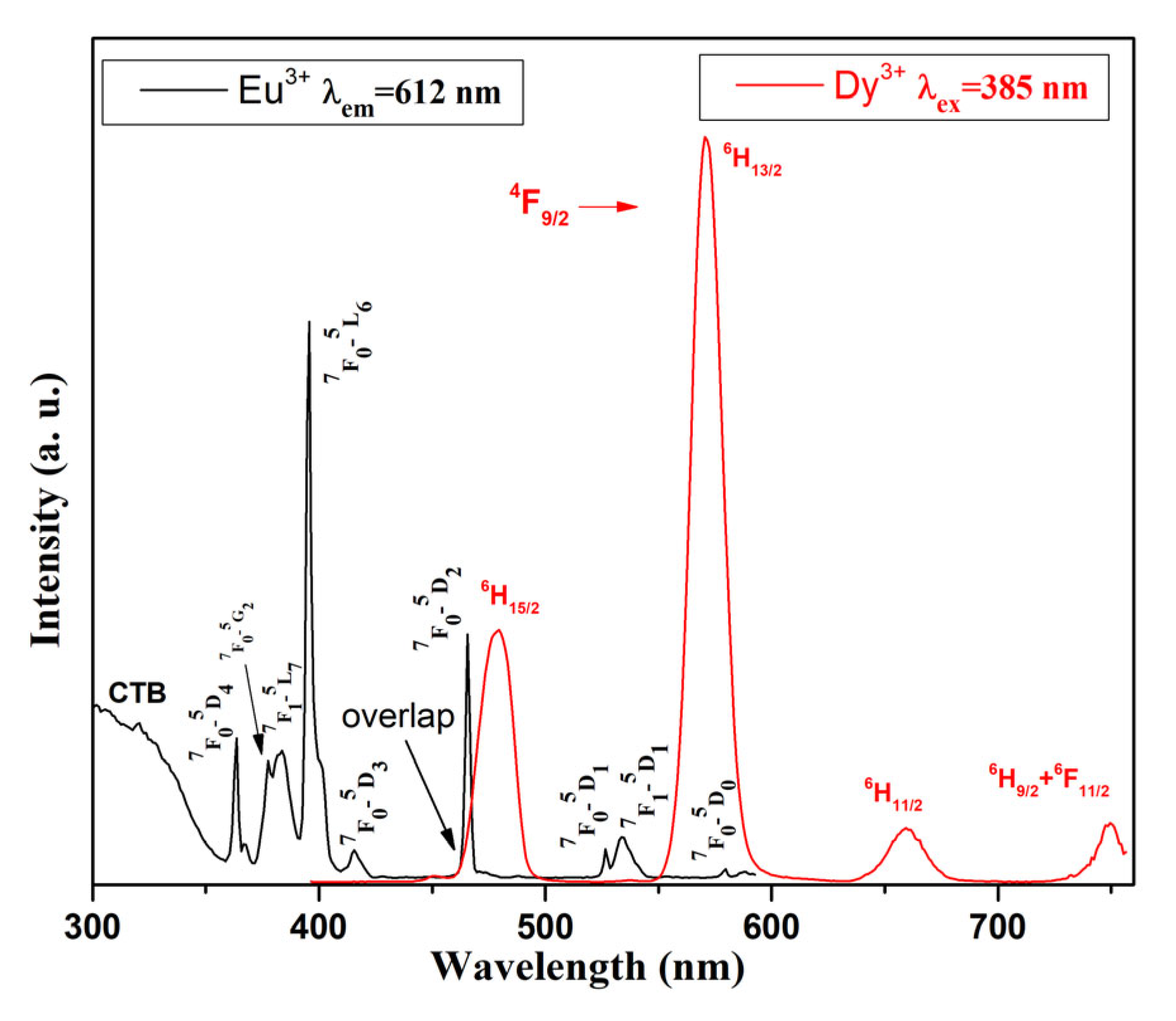
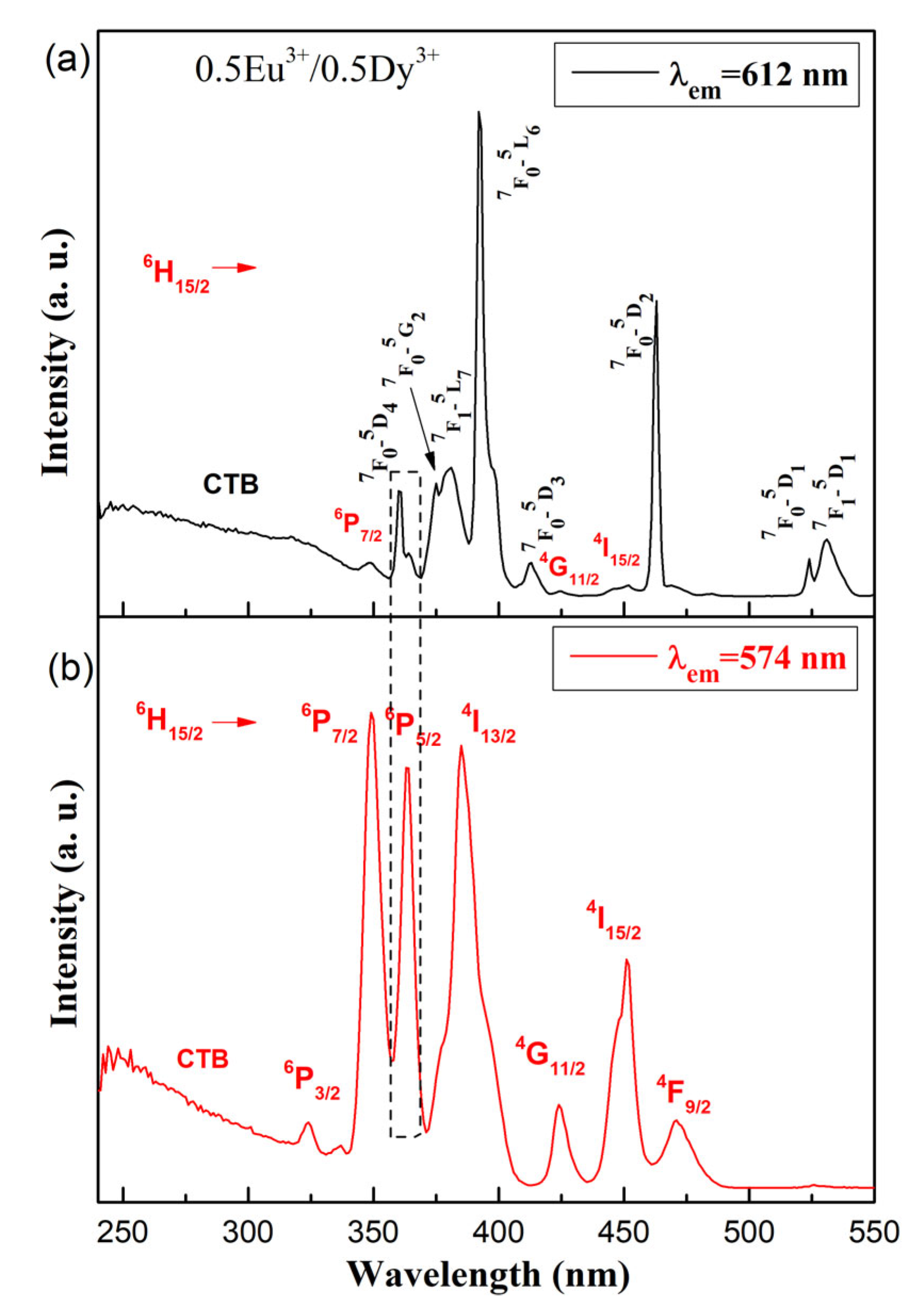

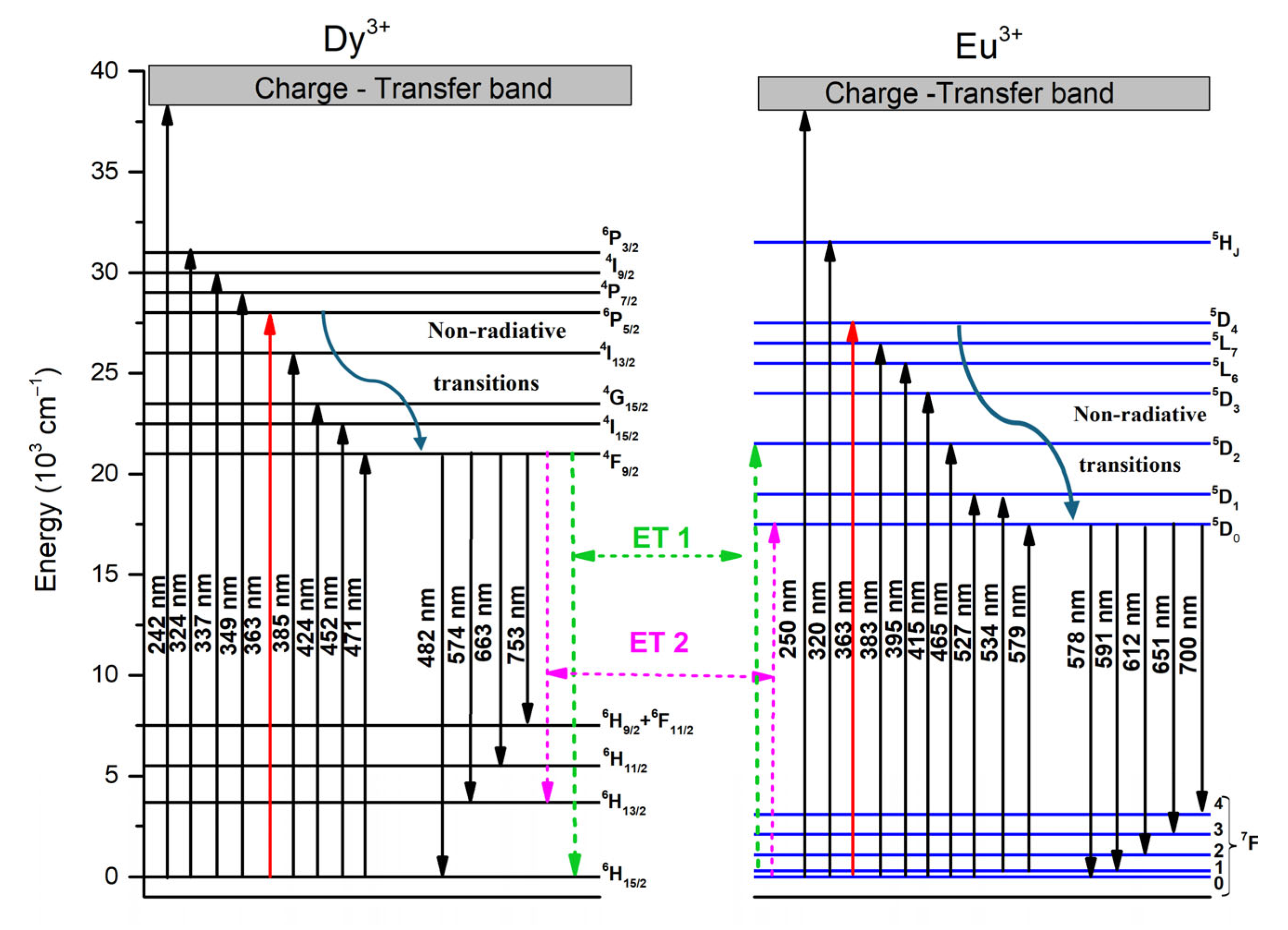
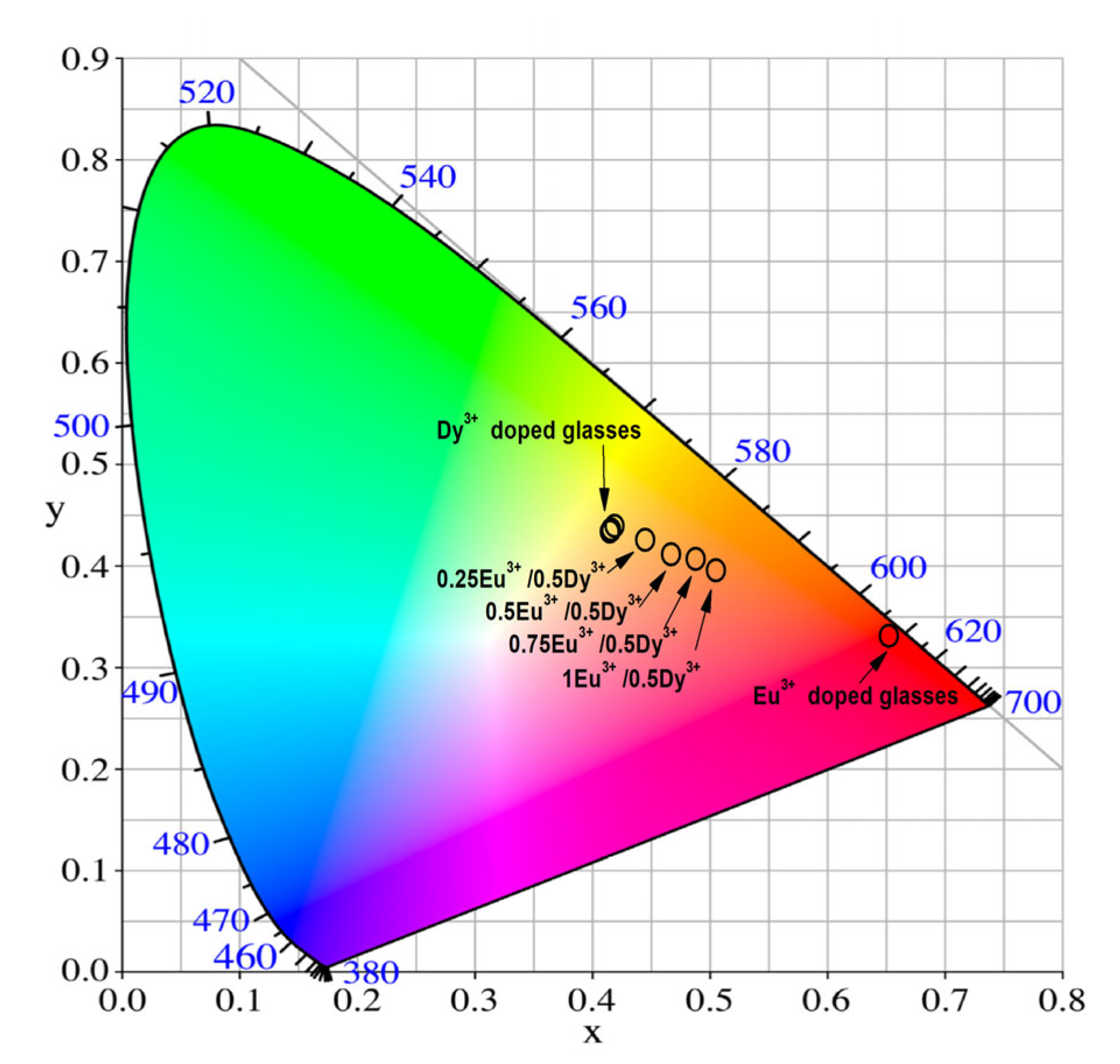
| Sample ID | ZnO | B2O3 | WO3 | Nb2O5 | Dy2O3 | Eu2O3 |
|---|---|---|---|---|---|---|
| 0.25Dy | 50 | 40 | 5 | 5 | 0.25 | - |
| 0.5Dy | 50 | 40 | 5 | 5 | 0.5 | - |
| 0.75Dy | 50 | 40 | 5 | 5 | 0.75 | - |
| 1Dy | 50 | 40 | 5 | 5 | 1 | - |
| Sample ID | ZnO | B2O3 | WO3 | Nb2O5 | Dy2O3 | Eu2O3 |
|---|---|---|---|---|---|---|
| 0.5Dy-0.25Eu | 50 | 40 | 5 | 5 | 0.5 | 0.25 |
| 0.5Dy-0.5Eu | 50 | 40 | 5 | 5 | 0.5 | 0.5 |
| 0.5Dy-0.75Eu | 50 | 40 | 5 | 5 | 0.5 | 0.75 |
| 0.5Dy-1Eu | 50 | 40 | 5 | 5 | 0.5 | 1 |
| Sample ID | ρg | Vm | Vo | OPD |
|---|---|---|---|---|
| 0.25Dy | 3.887 ± 0.005 | 24.28 | 11.51 | 86.90 |
| 0.5Dy | 3.923 ± 0.004 | 24.29 | 11.46 | 87.28 |
| 0.75Dy | 3.926 ± 0.004 | 24.51 | 11.56 | 86.50 |
| 1Dy | 3.949 ± 0.003 | 24.60 | 11.55 | 86.59 |
| Sample ID | ρg | Vm | Vo | OPD |
|---|---|---|---|---|
| 0.5Dy-0.25Eu | 3.927 ± 0.004 | 24.49 | 11.46 | 87.28 |
| 0.5Dy-0.5Eu | 3.956 ± 0.002 | 24.53 | 11.52 | 86.83 |
| 0.5Dy-0.75Eu | 3.968 ± 0.003 | 24.68 | 11.53 | 86.71 |
| 0.5Dy-1Eu | 3.991 ± 0.003 | 24.76 | 11.52 | 86.83 |
| Glass Composition | λex (nm) | Chromaticity Coordinates (x, y) |
|---|---|---|
| 50ZnO:40B2O3:5WO3:5Nb2O5:0.25Dy2O3 | 385 | (0.412, 0.446) |
| 50ZnO:40B2O3:5WO3:5Nb2O5:0.5Dy2O3 | 385 | (0.416, 0.452) |
| 50ZnO:40B2O3:5WO3:5Nb2O5:0.75Dy2O3 | 385 | (0.413, 0.448) |
| 50ZnO:40B2O3:5WO3:5Nb2O5:1Dy2O3 | 385 | (0.413, 0447) |
| 50ZnO:40B2O3:5WO3:5Nb2O5:0.5Eu2O3 | 394 | (0.649, 0.343) |
| 50ZnO:40B2O3:5WO3:5Nb2O5:0.5Dy2O3:0.25Eu2O3 | 363 | (0.442, 0.438) |
| 50ZnO:40B2O3:5WO3:5Nb2O5:0.5Dy2O3:0.5Eu2O3 | 363 | (0.464, 0.424) |
| 50ZnO:40B2O3:5WO3:5Nb2O5:0.5Dy2O3:0.75Eu2O3 | 363 | (0.485, 0.419) |
| 50ZnO:40B2O3:5WO3:5Nb2O5:0.5Dy2O3:1Eu2O3 | 363 | (0.502, 0.408) |
Disclaimer/Publisher’s Note: The statements, opinions and data contained in all publications are solely those of the individual author(s) and contributor(s) and not of MDPI and/or the editor(s). MDPI and/or the editor(s) disclaim responsibility for any injury to people or property resulting from any ideas, methods, instructions or products referred to in the content. |
© 2025 by the authors. Licensee MDPI, Basel, Switzerland. This article is an open access article distributed under the terms and conditions of the Creative Commons Attribution (CC BY) license (https://creativecommons.org/licenses/by/4.0/).
Share and Cite
Milanova, M.; Yordanova, A.; Aleksandrov, L.; Iordanova, R.; Petrova, P. Synthesis and Photoluminescent Properties of Dy3+-Doped and Dy3+/Eu3+ Co-Doped 50ZnO:40B2O3:5WO3:Nb2O5 Glass. Molecules 2025, 30, 2229. https://doi.org/10.3390/molecules30102229
Milanova M, Yordanova A, Aleksandrov L, Iordanova R, Petrova P. Synthesis and Photoluminescent Properties of Dy3+-Doped and Dy3+/Eu3+ Co-Doped 50ZnO:40B2O3:5WO3:Nb2O5 Glass. Molecules. 2025; 30(10):2229. https://doi.org/10.3390/molecules30102229
Chicago/Turabian StyleMilanova, Margarita, Aneliya Yordanova, Lyubomir Aleksandrov, Reni Iordanova, and Petia Petrova. 2025. "Synthesis and Photoluminescent Properties of Dy3+-Doped and Dy3+/Eu3+ Co-Doped 50ZnO:40B2O3:5WO3:Nb2O5 Glass" Molecules 30, no. 10: 2229. https://doi.org/10.3390/molecules30102229
APA StyleMilanova, M., Yordanova, A., Aleksandrov, L., Iordanova, R., & Petrova, P. (2025). Synthesis and Photoluminescent Properties of Dy3+-Doped and Dy3+/Eu3+ Co-Doped 50ZnO:40B2O3:5WO3:Nb2O5 Glass. Molecules, 30(10), 2229. https://doi.org/10.3390/molecules30102229






